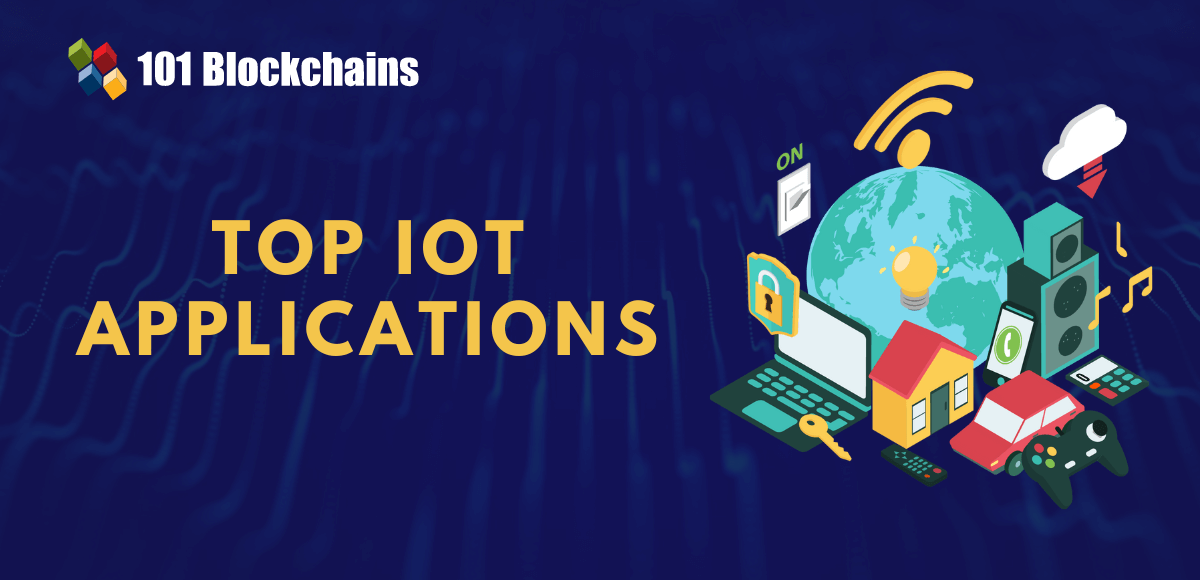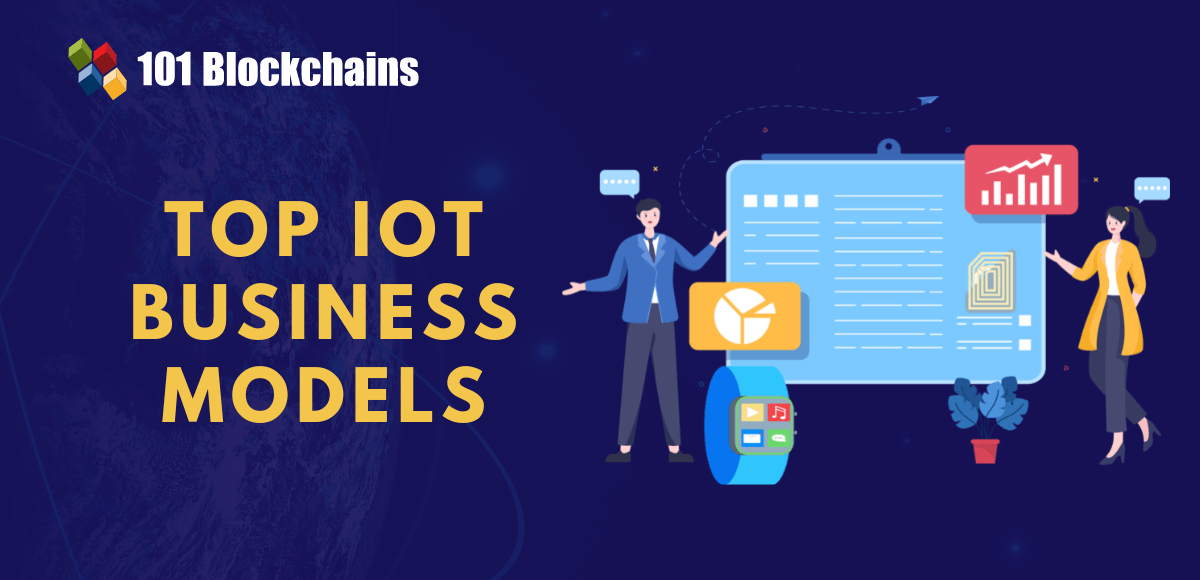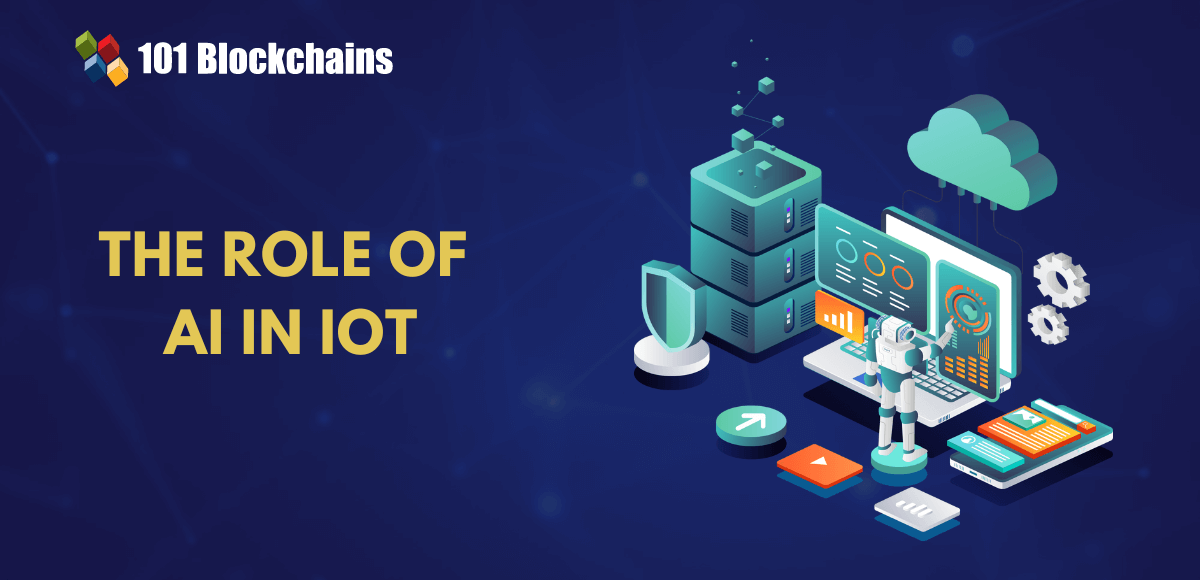Learn how blockchain truly works, master key definitions, and uncover what makes smart contracts so "smart." Dive into the fundamentals, gain valuable insights, and start your blockchain journey today!
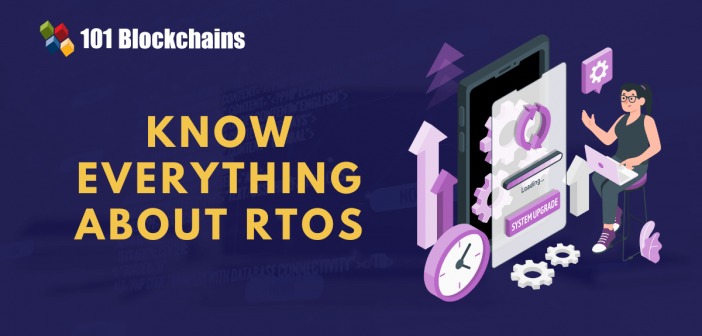
- IoT
James Howell
- on March 15, 2023
What is RTOS, and why You Should Use it for Your IoT Devices
Embedded software engineers are one of the most in-demand job roles within the IoT landscape. How is embedded software relevant now? Embedded software could serve significant value advantages in transforming the use of IoT. The discussion around embedded software also invites attention to ‘what is RTOS’ and its uses.
Application developers have a better time with the transition toward new programming languages such as C++, Python and JavaScript. On the other hand, embedded programmers are still struggling with the transition to C from assembly language. The addition of sensors and actuators in many devices you use every day showcases how embedded programmers would have to create the relevant IoT applications.
The domain of embedded systems programming relies on two variants of firmware development, such as bare metal and RTOS-based. You must have doubts about how does RTOS work and the ways in which it influences IoT hardware. The following discussion provides a detailed introduction to RTOS and important considerations for using it in IoT.
Definition of RTOS
The two common firmware development approaches used in IoT include RTOS-based and bare metal or super loop model of development. You should learn about the differences between them to find the definition of RTOS. The answers to questions like ‘What is RTOS in IoT?’ would point toward the problems with flexibility in IoT firmware development. The bare metal approach for embedded systems involves only one loop, which features the task code without interrupts.
In the case of bare metal development, the firmware code or application logic for the IoT solution is scripted with peripheral registers featuring memory mapping. The script of the application code in bare metal programming enables the operations of the firmware on the microcontroller hardware. Interestingly, you wouldn’t depend on abstraction layers, including operating systems or device drivers.
You might have searched for ‘How RTOS is used in IoT?’ while reflecting on best practices for development in embedded systems. In the case of RTOS-centric embedded systems, all the tasks must be scheduled within a specific time. Simultaneously, Real-time operating system also enabled easy scheduling of aperiodic or spontaneous tasks. On top of it, RTOS-based systems feature OS kernels alongside device drivers that can serve as the interfacing bridge between the microcontroller hardware and the actual logic of the application.
Want to understand the fundamentals of the Internet of Things (IoT)? Enroll Now in IoT Fundamentals Course!
Types of RTOS
Operating systems serve as computer applications for supporting the basic functions of a computer alongside providing services to other applications on the computer. The applications could offer functionalities required for the user on the concerned computer. Services of the OS ensure faster application development alongside simpler operations and maintenance. Now, you must have doubts like ‘Why should we use RTOS in IoT?’ and answers to the questions can clarify their applications.
The Real-Time Operating System or RTOS is an essential software component that helps in faster switching between tasks. As a result, it ensures that the OS executes multiple applications on a single processing core simultaneously. On the other hand, the processing core would execute only one program at a time. RTOS creates the illusion of executing multiple programs simultaneously by switching between each programming thread and task.
You can understand “how does RTOS work” by comparing it with embedded Linux. At the same time, you cannot ignore the significance of learning about types of RTOS developers could capitalize on for valuable benefits. Here are the essential types of real-time operating system.
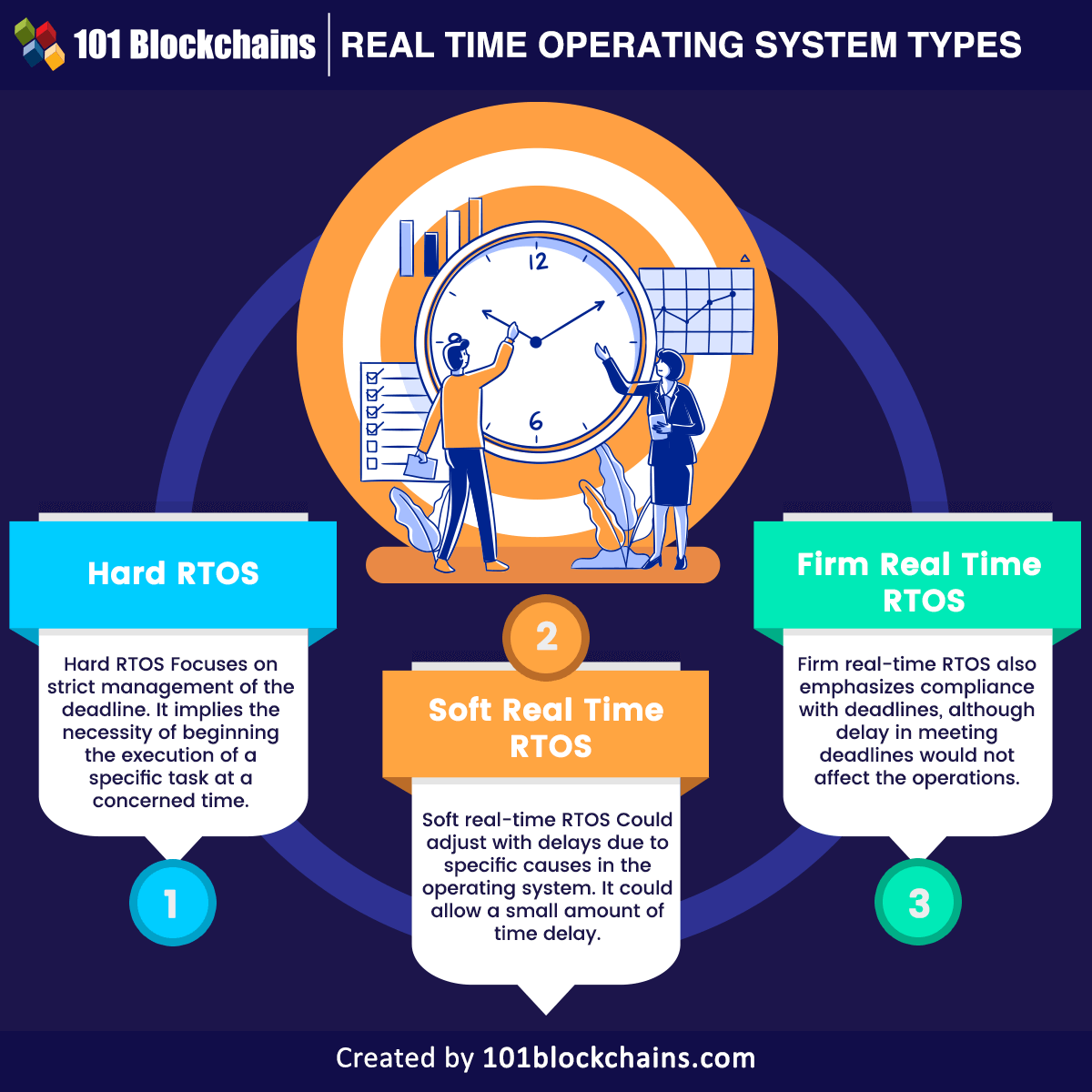
-
Hard RTOS
The Hard RTOS focuses on strict management of the deadline. It implies the necessity of beginning the execution of a specific task at a concerned time. At the same time, the tasks should also be executed within a specific duration, such as in examples of critical care systems.
-
Soft Real Time
The review of RTOS examples with soft real-time modeling would point to the online transaction and price quotation systems. Soft RTOS could adjust with delays due to specific causes in the operating system. Even with the deadline for the concerned job, soft real-time RTOS could allow a small amount of time delay. Such types of RTOS have earned the name for soft management of deadlines.
-
Firm Real Time
The firm real-time RTOS also emphasizes compliance with deadlines, although delay in meeting deadlines would not affect the operations. However, firm real-time RTOS could show some undesired effects in the event of delays, such as a reduction in product quality.
Want to familiarize yourself with the technology stack associated with IoT? Enroll Now in Internet Of Things (IoT) – Intermediate Level Course!
Working of RTOS
The most crucial highlight in a guide to RTOS would focus on the working of real-time operating system. You can understand real-time operating system advantages and disadvantages with a clear impression of how RTOS works. The difference between embedded Linux and RTOS could offer an idea about how RTOS functions.
Embedded Linux uses Linux kernel for embedded devices, albeit with differences from standard Linux OS. It is a customized variant of Linux tailored for embedded systems, with a smaller size, lesser processing power and minimalistic design. Embedded Linux is useful for running device-specific applications tailored for specific purposes.
On the other hand, the features of RTOS apply to applications that rely on fixed processing time. The technical explanation for RTOS paints it as a time-sharing system that relies on clock interrupts for implementing priority sequences in process execution. In the case of high-priority applications, the system would generate the interrupt and stop the operational low-priority processes.
Real-time operating systems require considerably lesser operational memory in comparison to Embedded Linux. In addition, it also helps synchronise the processes for enabling communication with each other, which could facilitate efficient use of resources.
Reasons to Use RTOS
The next crucial aspect in discussions around ‘what is RTOS’ points at the reasons for using RTOS. Real-time operating systems provides the assurance of better productivity based on the following factors.
-
Preemptive Paradigm
The first important highlight in defining ‘What is RTOS in IoT?’ would draw attention toward the preemptive paradigm. In the case of complicated real-time application designs, the preemptive multitasking design paradigm is useful for managing a continuously scalable code base. The preemptive design paradigm is essential for ensuring that response times for real-time events are independent. Therefore, it can add new functions without disruptions in existing real-time devices.
-
Better Complexity Management
The discussions about real-time operating system advantages and disadvantages also draw attention to complexity management. Decomposing the project code into different independent threads and processes could help make the project more manageable. The different threads could help easier synchronization and communication while utilizing OS services, including event flags, message queues, semaphores and mutexes.
Efficient CPU Resource Usage in Power Consumption
The use of interrupts in RTOS examples shows the possibility of removing polling concerns. As a result, processor resources could emerge as ideal resources for driving productive work. At the same time, real-time operating system-based applications also empower power-saving methods of operation, which can be implemented during system idle time. The power consumption portfolio depends on the periodic exit and would re-enter the low-power status for processing tick interrupts.
In addition, cases of high tick interrupt would affect the potential power consumption advantages. With each tick, the total time and energy required for entering and moving out of a low-power state could overcome the gains through power savings. The features of real-time operating system include tickles idle mode in certain cases, preventing periodic tick interrupts within the idle periods.
Subsequently, restarting tick interrupts would also invoke a correcting modification in the real-time operating system tick count value. Upon stopping the tick interrupt, the microcontroller will stay in the deep power-saving state before an interrupt happens. The process could happen when the RTOS kernel has to shift the identity of tasks to a Ready task.
Learn the latest insights about the IoT (Internet of Things) and understand how it’s related to the blockchain with industry experts with IoT Skill Path!
Challenges of RTOS in IoT
The guides on “How RTOS is used in IoT?” would draw attention to the challenges incurred by RTOS. IoT manufacturers have to worry about different embedded systems challenges to resolve scalability, connectivity, safety, modularity and security issues. In addition, RTOS must keep pace with the emerging needs for cutting-edge features in IoT networks driven by new devices and infrastructure. What are the important challenges of using RTOS in IoT? The answer would point you toward the following crucial requirements for RTOS implementations in IoT.
-
Modularity
Intelligent devices have to move over the monolithic functions and infrastructures. The clarity in responses to “Why should we use RTOS in IoT?” would draw attention to the necessity of adapting to changing needs of the network. Therefore, RTOS architectures must follow a modular and upgradeable design, which would cope with emerging requirements.
-
Scalability
IoT could help create incentives for manufacturers with the assurance of a broader product portfolio. An understanding of how does RTOS work could help you choose a real-time operating system which can scale up to meet unique requirements in different use cases. RTOS should be able to address the processing power needs, footprint and functionality of IoT systems.
-
Connectivity
The essential highlight among RTOS requirements for IoT implementation points to connectivity. Real-time operating system must support popular communication protocols and standards. In addition, the real-time operating system should also provide high-performance and innovative networking capabilities.
-
Security
Another important highlight of a promising RTOS implementation is the security aspect. Pervasive connectivity through IoT opens up a larger playground for security threats. Therefore, discussions on real-time operating system advantages and disadvantages could help recognise how an RTOS should offer the flexibility for designing the embedded system to achieve desired security.
-
Safety
The efficiency of an real-time operating system in IoT development would also focus on safety. How can RTOS play a role in ensuring safety? IoT manufacturers must look up to the RTOS vendors to deliver the required safety and security features alongside certifications for end products.
-
Features
The RTOS must also offer a robust feature set like a conventional operating system. The feature set could help IoT manufacturers differentiate their product offerings and secure a competitive advantage. The essential features include a user interface and multi-core processors. In addition, the flexibility for customized real-time operating system also opens up new avenues for IoT implementations and efficiency.
Curious to know how the IoT business mechanisms work? Enroll Now in the Internet Of Things Business Impact Course!
Bottom Line
The detailed guide on how RTOS works and its benefits showcase the efficiency of RTOS for IoT. The continuously growing ecosystem of embedded devices can rely on real-time operating system advantages and disadvantages for charting a suitable course for implementation. In the long run, RTOS can open new doors for efficiency in manufacturing IoT solutions. First of all, real-time operating system could improve speed and ensure users’ security and privacy.
On top of it, real-time operating system also creates the perfect foundation for including cutting-edge features in IoT implementations. The operating principles of RTOS offer a significant advantage to IoT manufacturers with options for creating scalable solutions for the future. Learn more about RTOS and important hardware requirements for real-time operating systems in detail.




